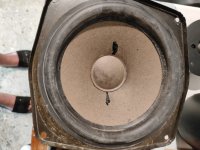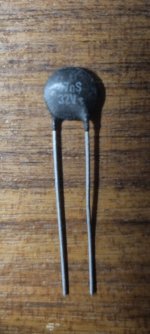Black ceramics? Interesting! Never seen before.Preamp is done. I got tyred after a long day, so I will rather go to sleep and build PSU tomorrow morning.
View attachment 1376190
I'm thinking... what if I add just power stage made of 2 transistors after NE5532?
I see alot of gain and it could go even higher, can this be done or is there something standing in the way? Is current from NE sufficient?
I did some research, but the is alot of mixed info on doing something like that.
I see alot of gain and it could go even higher, can this be done or is there something standing in the way? Is current from NE sufficient?
I did some research, but the is alot of mixed info on doing something like that.
Current from the NE5532 is barely enough, even to drive MJE15030/1. With lower gain transistors, the CFP option is needed. You have some marginal stability already, do you want more? If you are going to do that, just get another 5532. Make them into separate problems rather than a compound one thats harder to unravel when something goes wrong.
Ok, noted.
It was a quick tought before work, I'm googling the topic as we speak and more I see, more I think this is not the best idea at all.
It was a quick tought before work, I'm googling the topic as we speak and more I see, more I think this is not the best idea at all.
And people make a Big Deal over capacitors. Any really high capacitance density ceramic is a class 2, which has a nonlinear voltage characteristic. They can and do cause measurable distortion. But the level is so far below what you will be getting for any of the simple power stages being considered that it’s just not worth worrying about here. Not to mention the distortion produced by a small speaker when driven with that much low frequency content.
Thanks for clarification on capacitors.
I'm quickly going to buy parts for TDA2030 as store closes soon.
I'll make dual supply version from datasheet and see how it sounds all together. A bit powerfull at +-16v, but will see.
I'm quickly going to buy parts for TDA2030 as store closes soon.
I'll make dual supply version from datasheet and see how it sounds all together. A bit powerfull at +-16v, but will see.
That was my first intention. Later I choosed not to go class A at all... Too much heat, too big power supply requirement and too big heatsink needed for this project. To top it of, old cheap full range speaker in unsealed cabinet probably wouldn't benefit enough.
Wooden cabinet, radio that will play every day in the kitchen... I rather moved away from class A.
But 1969 is on my wish list and I would build 2 cabinets with quality full range speakers for it 🙂 someday...
Wooden cabinet, radio that will play every day in the kitchen... I rather moved away from class A.
But 1969 is on my wish list and I would build 2 cabinets with quality full range speakers for it 🙂 someday...
True, large part of the consumer audio uses polyester film & electrolytics. Almost all brands, Sony, Denon, Pioneer you name it.And people make a Big Deal over capacitors...
Polyester and electrolytic are “better” than class 2 ceramics. But I’ve had plenty of old table radios that were chock full of Z5U’s, and never could I point to the capacitors as being a source of bad sound. Nor did I ever think they would benefit from changing them all.
TDA 2030A will give 10W into 8 E, and a bit above 16 into 4E loads at 32V.
Might be too much for the speaker, I would run it about 20V (+/-10V)
Might be too much for the speaker, I would run it about 20V (+/-10V)
Same here. Gathering all the parts (Active) for my wish list. At the moment I'm happy with my Gainclone & Full range spkrs.But 1969 is on my wish list and I would build 2 cabinets with quality full range speakers for it 🙂 someday...
EDIT- For passive components, i purchased Through hole NPO ceramics & Film capacitors only. All sealed pack.
Last edited:
Even +/-9V is good enough. The min supply requirement of TDA2030A is +/-6VDC.
EDIT:- Here regulated power supply may work for your need. You just need oldy goldy 3pin regulators. Simple & should work fine.
EDIT:- Here regulated power supply may work for your need. You just need oldy goldy 3pin regulators. Simple & should work fine.
Last edited:
I had success with replacing just electrolytics before in old amps, ussualy the biggest improvements were either it started working or hum/buzz was removed/reduced or clipping was gone, every other improvement I can`t vouch for because it would be subjective. (mainly 80s products)Polyester and electrolytic are “better” than class 2 ceramics. But I’ve had plenty of old table radios that were chock full of Z5U’s, and never could I point to the capacitors as being a source of bad sound. Nor did I ever think they would benefit from changing them all.
I totaly agree with power supply voltage, however I`m waiting to see what will actually happen, because I had "25w" woofer from same manufacturer / era as a kid, I was butchering it with 100w every day and it didn`t die, however it had rubber surround (same material as bike wheel tube).

Not my photo and not exact speaker, whis is "40w" version of what I had back in a day.
I will probably go with regulated, I didn`t bother to check yet, but for my singal vpp NE5532 doesn`t need that high of a voltage also.

Not my photo and not exact speaker, whis is "40w" version of what I had back in a day.
I will probably go with regulated, I didn`t bother to check yet, but for my singal vpp NE5532 doesn`t need that high of a voltage also.
From my understanding regulated power supply is the best option for TDA2030A & your preamp. It'll not take much of the space, two regulator for positive & negative supply rails. 1000uf before the regs & 1uf film after. Small but thick to-220 heatsink with vertical fins will be adequate.
I had success with replacing just electrolytics before in old amps, ussualy the biggest improvements were either it started working or hum/buzz was removed/reduced or clipping was gone, every other improvement I can`t vouch for because it would be subjective. (mainly 80s products)
Electrolytics can and do go bad, especially older technology and bottom of the barrel brands. They dry out. Ceramics have an actual wear out mechanism due to charge trapping, but I challenge anybody to reach it in an audio application. I believe even polypropylene has the same lifetime limitations for the same reasons. And you never see one of those die except from extreme overvoltage.
- Home
- Amplifiers
- Solid State
- Amplifier suggestion for old 3w speaker
